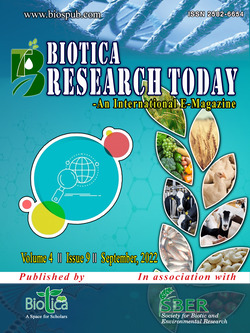
Potential of Agroforestry for Improvement of Degraded Lands and Soil
R.K. Meena*
Dept. of Forestry, Dr. Rajendra Prasad Central Agricultural University, Pusa, Samastipur, Bihar (848 125), India
S.L. Singh
Dept. of Forestry, Dr. Rajendra Prasad Central Agricultural University, Pusa, Samastipur, Bihar (848 125), India
Tulika Kumari
Dept. of Agricultural Economics, Dr. Rajendra Prasad Central Agricultural University, Pusa, Samastipur, Bihar (848 125), India
DOI: NIL
Keywords: Agroforestry, Degraded land, Nutrient cycling, Productivity
Abstract
Approximately 96.40 mha area of the country is under degraded land, which is about 29.32% of total geographical area. It indicates that the degradation of land is the major problem in India. The major factors responsible for land degradation are physical, chemical and biological factors. Human activities like shifting cultivation, overgrazing, over exploitation of forest, less management of land, over dose of chemical fertilizers and population growth are also responsible for the land degradation. Under this situation, agroforestry is one of the popular practices adopted by various countries to improve the degraded land through nutrient cycling, runoff control, increase in the soil carbon and biomass. Agroforestry systems like fellow species on shifting cultivation, alley cropping, wind break and shelterbelt etc. are commonly used practices to improve the degraded land. Many studies have proved that agroforestry can check soil erosion to some extent, increase soil fertility, and reduce salinity, alkalinity, acidity and desertification.
Downloads
not found
Reference
Gupta, S.R., Dagar, J.C., Teketay, D., 2020. Agroforestry for Rehabilitation of Degraded Landscapes: Achieving Livelihood and Environmental Security. Agroforestry for Degraded Landscapes. (Eds.) Dagar, J.C., Gupta, S.R. and Teketay, D. Springer Nature, Singapore. pp. 23-68.
Tomar, J.M.S., Ahmed, A., Bhat, J.A., Kaushal, R., Shukla, G., Kumar, R., 2021. Potential and Opportunities of Agroforestry Practices in Combating Land Degradation. In: Agroforestry - Small Landholder’s Tool for Climate Change Resiliency and Mitigation. (Eds.) Shukla, G., Chakravarty, S., Panwar, P., Bhat, J.A. IntechOpen. p. 3. DOI: 10.5772/intechopen.97843.
